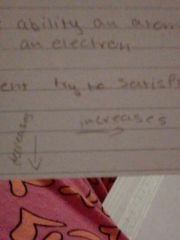![]()
![]()
![]()
Use LEFT and RIGHT arrow keys to navigate between flashcards;
Use UP and DOWN arrow keys to flip the card;
H to show hint;
A reads text to speech;
54 Cards in this Set
- Front
- Back
- 3rd side (hint)
|
RutherFord's experiment supported |
An atom nucleus is smaller, dense and has positive charge |
Nucleus |
|
|
Density of an atom's nucleus |
The nucleus occupies little of the atoms volume contains most of its mass |
|
|
|
Rutherford experiments discovered |
Protons |
In the nucleus |
|
|
What is in the nucleus of an atom |
Protons and neutrons |
|
|
|
Group 1A |
Alkali metals |
It's a metal |
|
|
Theory Def. |
Have been repeatedly confirmed |
|
|
|
2 properties of metals |
High density Strong |
|
|
|
Ionic bonds |
Metal plus nonmetal |
|
|
|
Atoms |
Building blocks of matter |
|
|
|
Element |
A substance that cannot be separated into a simpler substance |
|
|
|
Electronegativity element |
Flurorine |
An element noble hass |
|
|
Conservation of matter |
In any process matter is neither created or destroyed |
|
|
|
Thompson discovered the |
Electron |
|
|
|
Def ionization energy |
Energy needed to remove an electron from an atom |
|
|
|
What group had the Lowest ionazation energy |
Alkali metals They want to get rid of an electron Have a weak nuclear force |
Metals |
|
|
Def hypothesis |
Limited evidence starting point for further investigation |
|
|
|
Def Control variable |
The standard that is used for comparison |
|
|
|
Def Dependant variable |
Is what you measure in the experiment |
|
|
|
Spectral lines are result of |
Electrons release energy and return to a low energy levels |
|
|
|
Def Observation |
An act of viewing a factor occurance |
|
|
|
Quantitative |
Amount |
Quantity |
|
|
Semimetals |
Metals and nonmetals Insulate and conduct electricity |
|
|
|
Def electron affinity |
The ability am atom has to accept an electron |
|
|
|
Group 8A |
Noble gasses |
Gasses |
|
|
What is the periodic law |
Similarities chemical / physical reoccur |
|
|
|
What family does not make ions and why |
Noble gasses They have a full outer shell of electrons |
|
|
|
Group 7A |
Halogens |
|
|
|
2 properties of non metals |
Poor conductors of heat They are brittle |
|
|
|
Def Isotopes |
Same number of protons different number of neutrons |
|
|
|
Ionic bonding |
Ions are held together by the electrostatic attraction of opposite charges |
|
|
|
Octet rule |
Atoms gain,lose or share electrons in order to have 8 valence electrons in their outer shell |
|
|
|
Atomic radius |
Distance from the center of the nucleus to the outside shell of electrons |
|
|
|
Elements try to satisfy the octet rule |
Electron affinity |

|
|
|
Def Electronegativity |
The attaraction that an atom has for electrons in a chemical bond |
|
|
|
Nonmetals |
Poor conductors of heat Make negative ions |
|
|
|
Symbol for change |
Triangle 🔼 |
|
|
|
Collision theory |
Atoms, ions, and molecules can react to form products when they collide with one another |
|
|
|
Catalyst |
Increase reaction rate without being consumed in he reaction |
|
|
|
Solute |
Substance being disolved |
|
|
|
Solvent |
Present in greater amount doing the dissolving dissolver |
Dissolver |
|
|
Saturated solution |
No more substance dissolves |
|
|
|
Unsaturated solution |
More substance dissolves |
|
|
|
Supersaturaded solution |
Becomes unstable crystals form |
|
|
|
How does Pressure affect solubility of gasses |
Tend to dissolve the best |
|
|
|
Def Intramolecular |
Forces that exist inside the molecule |
|
|
|
Intermolecular |
Forces of attraction between neighboring molecules |
|
|
|
Equilibrium |
Is established when forward and reverse reaction rates are equal |
|
|
|
Properties of acids |
Sour taste Conduct electricity Change indicators |
|
|
|
Bases |
Bitter taste Conduct electricity React with acids |
|
|
|
Conjugated bases |
Remainder of the original acid |
|
|
|
Conjugated acid |
When the base gains a hydrogen ion |
|
|
|
Half life |
Time it takes for one half of a radioactive sample to decay |
|
|
|
What happens to the nucleus of an atom during fission |
The splitting of the nucleus into smaller fragments |
|
|
|
What happens to the nucleus during fusion |
Nuclei split |
|

